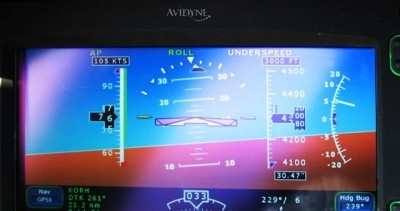Unit Provides Enhanced Safety For High Work-Load IFR
Environments
Avidyne Corporation has announced the Lincoln, MA-based company
has received an amended Supplemental Type Certificate (STC)
approval for their recently-certified DFC90 Digital Flight Control
System which enables speed-based Flight Envelope Protection.

Flight Director Underspeed Condition
This new feature is designed to eliminates inadvertent
autopilot–induced over-speed situations when autopilot is
engaged. For flight envelope protection, available lift and speed
margin are calculated constantly in the background whenever any
modes, including Flight Director, are in operation. Overspeed is
handled with anticipation and minimal but effective inputs. In
Flight Director modes, actions appear as guidance cues with
corrections blended into the "V-bar" commands.
“The certification of Flight Envelope Protection is a
significant achievement for Avidyne, as well as a considerable step
forward in general aviation autopilot performance and
safety,” said Avidyne President and CEO, Dan Schwinn.
“Avidyne is committed to continuously enhancing safety for
all of our customers, and Flight Envelope Protection as well as the
Straight and Level function and other capabilities of the DFC90
establish a new watermark in general aviation autopilot performance
and safety.”
The DFC90 is an attitude-based digital autopilot system that is
designed as a slide-in replacement for the S-TEC55X autopilot in
existing Entegra-equipped Cirrus SR20 and SR22 aircraft. The
significant performance and safety benefits of the attitude-based
DFC90 make it a very attractive upgrade for the more than 4,000
owners of Entegra-equipped Cirrus aircraft.
Avidyne’s speed-based Flight Envelope Protection virtually
eliminates autopilot-induced stalls (underspeed) and overspeeds,
which lead to a significant number of GA accidents. With Flight
Envelope Protection, the autopilot avoids exceeding the flight
envelope while providing visual and aural warnings to the
pilot.

The new Indicated Airspeed Hold (IAS) vertical mode includes a
dedicated Airspeed knob and a new airspeed bug on the PFD, and
provides a more elegant way to make Flight Level changes. The
“Straight & Level” button overrides all autopilot
modes and levels the aircraft in both pitch and roll from a wide
range of capture attitudes for an added measure of safety. The
Flight Director capability of the DFC90 is vastly improved and
greatly improves the ability to hand-fly approaches.
According to Schwinn, ease of installation and transition is one
of the DFC90’s attractive features. It is simply a
“box swap” or slide-in replacement for existing
rate-based STEC 55X flight computers which means much lower
installation costs.
Upgrading to the DFC90 only requires existing EXP5000 PFDs be
updated to Release 8.0 (hardware & software). The Release 8.0.2
software and Mod 55 PFD hardware upgrades enable the DFC90
autopilot to take advantage of the precision attitude information
of Entegra’s integrated Air Data and Attitude Heading
Reference System (ADAHRS), without the need for costly wiring
changes to the aircraft.
Another desirable trait is the unit’s robust data
recording capability. “What you hear often is ‘I was
flying along and it did x and it hasn’t done it
since,’” explained Schwinn. “And until now,
there’s nothing you can do about that when you’re in a
diagnostic situation. Our autopilot has an extensive fault
lining capability and we have the ability to take the data and go
back and retrace the exact event that occurred during the
flight.”

DFC 90
Schwinn adds the product has a number of forward-facing as well
as back-end improvements.
The new Indicated Airspeed Hold (IAS) vertical mode includes a
dedicated Airspeed knob and a new airspeed bug on the PFD, and
provides a more elegant way to make Flight Level changes.
The “Straight & Level” button overrides all
autopilot modes and levels the aircraft in both pitch and roll from
a wide range of capture attitudes for an added measure of safety.
The Flight Director capability of the DFC90 is vastly improved and
greatly improves the ability to hand-fly approaches.
FMI: www.avidyne.com
 NTSB Final Report: Rutan Long-EZ
NTSB Final Report: Rutan Long-EZ ANN FAQ: Turn On Post Notifications
ANN FAQ: Turn On Post Notifications Classic Aero-TV: ICAS Perspectives - Advice for New Air Show Performers
Classic Aero-TV: ICAS Perspectives - Advice for New Air Show Performers ANN's Daily Aero-Linx (06.28.25)
ANN's Daily Aero-Linx (06.28.25) Aero-News: Quote of the Day (06.28.25)
Aero-News: Quote of the Day (06.28.25)





